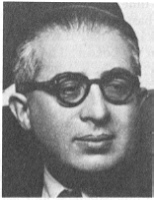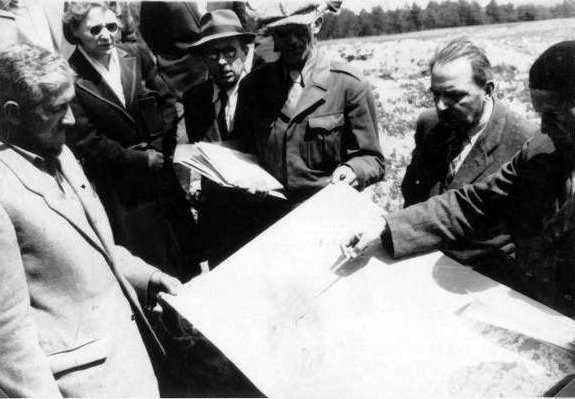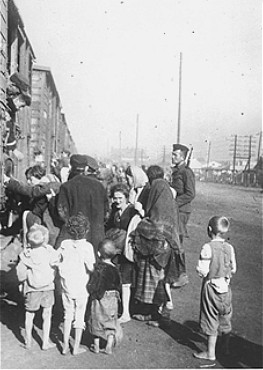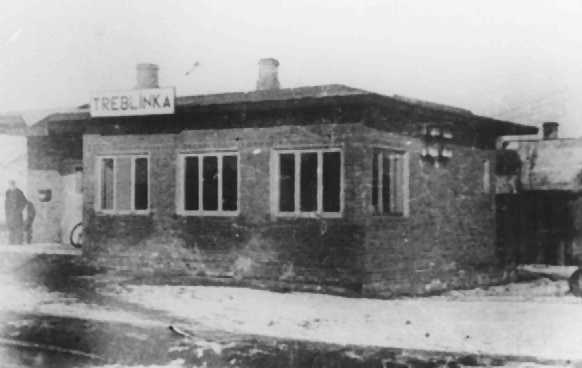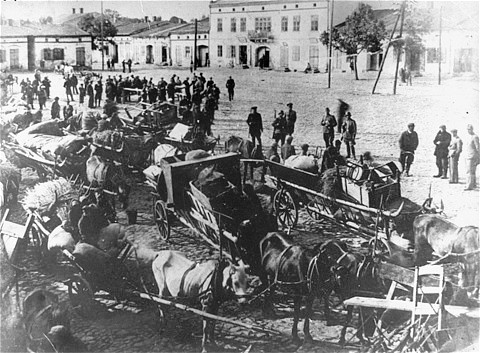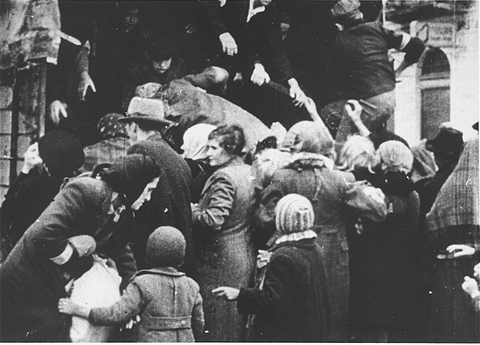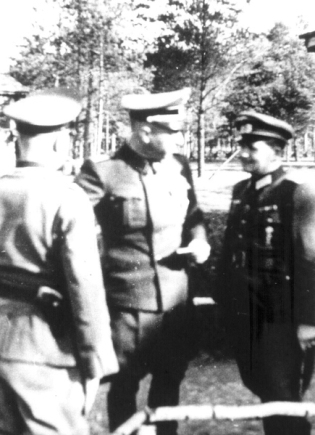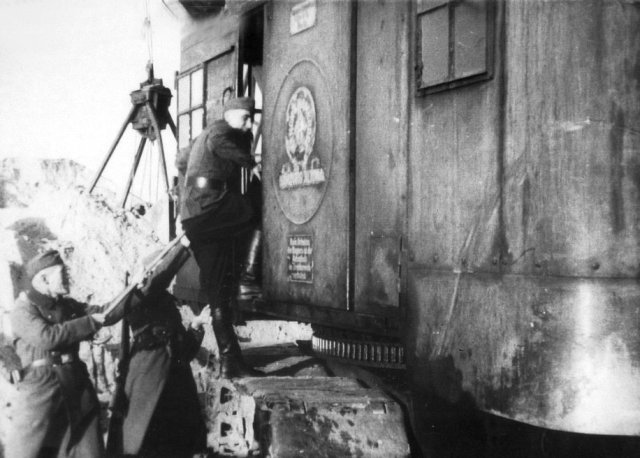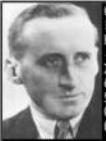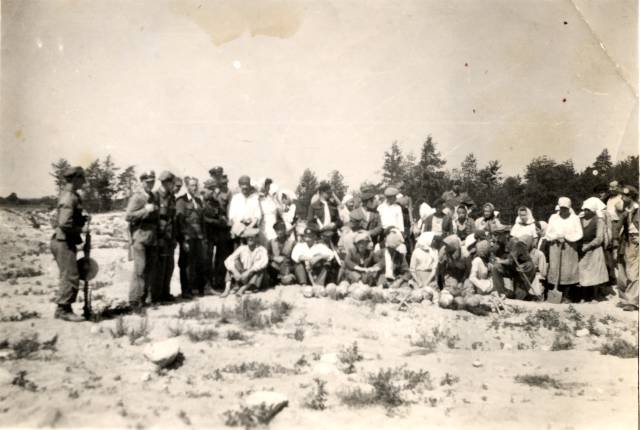Holocaust Education & Archive Research Team |
|
Trials Introduction to the Holocaust Trials
Trials
Interrogations & Testimonies
The IMT Series Nazi Justice
| |||||||
Samuel Rajzman Treblinka Death Camp An Account Before the American House Committee on Foreign Affairs in 1945 [Photos added to enhance the text]
In June 1942 placards bearing the following notice were posted on the walls of Warsaw, “Persons not employed in a German firm or the Jewish Community Administration are subject to immediate deportation from the ghetto, the able-bodied will be given employment.”
About the place of deportation nothing was known except that it was in the East. Next to the new posters there immediately appeared “Help Wanted” advertisements of German firms
The factories, stores, and workshops owned by the Jews had been turned over to German administrators, thus a great number of new German firms had been created. People paid fantastic sums (from five to twenty thousand zlotys, $1,000 to $4,000 per person) to find employment in a German firm and thus escape deportation. Those who still had anything to sell converted it into cash, but those that had no funds were doomed.
The day after this announcement it became known that Engineer Czerniakow, President of the Jewish Community had committed suicide. This report spread panic among the inhabitants of the ghetto. They knew that the German order concerning deportation had caused his suicide, but it was not clear why, all kinds of conjecture were advanced in explanation, but although the event boded no good, not even the worst pessimists had any idea what was really in store for the Polish Jews.
Next day the ghetto was surrounded by patrols posted at short intervals, these prevented anyone from leaving or entering the ghetto, even Gentiles who possessed special passes entitling them to circulate freely in the Jewish Quarter.
The ghetto now became a real inferno, processions of carts loaded with little children from orphanages and charity homes passed along the streets. These frightening and trembling mites were being deported, they did not know that never again would they see the city where they had been born and brought up.
Behind the children’s carts walked inmates from old people’s homes, aged men and women tottering on their feet, who were forbidden to end their lives in their own city. The Elite Guards escorted the processions. Then the Germans began to check the documents of the remaining inhabitants.
Soldiers swarmed everywhere in the streets and houses, they searched cellars and attics and asked everyone to show his identification papers. Those who could not prove that they were employed in a German firm were taken to the square where the deportees were rounded up.
These manhunts resulted in many victims, the slightest gesture of disobedience, the slightest hesitation before showing one’s paper’s, a smile the Germans did not find sufficiently pleasant, meant death on the spot. People were killed in their homes, in their courtyards, in the streets. In the end many preferred being deported to having their papers checked.
The deportees were crowded into trains, at first at the rate of six to eight thousand a day - subsequently the average daily contingent was 20,000. Several weeks later it became known that the Germans had murdered all the old people and children and that the able-bodied had allegedly been taken deep into Russia.
The news of the murder of the old folks and children aroused those who remained to desperate thoughts about counter-measures. When the Germans realised this, they forced the deportees to send letters to their families informing them that they were alive and that all was well with them.
The purpose of these letters which the Nazis frightened the deportees into writing before killing them, was to prevent further rumours, under the threat of death people wrote to relatives whom they were never to see again. This even took place on the square where the victims were gathered. In the terrible ordeal of the ghetto, children were taken from their mothers, people were beaten and murdered for no reason at all, those who ventured into the streets did not return.
By September, only 150,000 Jews of the original 600,000 remained in the Jewish community. However, it was impossible to obtain exact information on their condition because the ghetto was deserted; the employees of the German firms were now its only inhabitants
After a short respite, on September 7 1942, if I remember correctly new placards announced that all the remaining inhabitants of the ghetto must report to the assembly place of Mila, Nizka and Dzika Streets at 8am to have their identification papers checked
The horrible scene presented by this migration of 150,000 people with bundles on their backs can be imagined. Crowds of Jews filled the narrow streets within a few hours.
At exactly 8am cordons of troops barred all the exits to the above-named streets, those who were found in the ghetto beyond these streets were shot on the spot.
Several hours later a group of Elite Guards at one of the designated corners began to inspect the people. The Jews filed by these thugs in groups of four. The latter did not check any papers at all, but directed their victims as they pleased, to the right, which meant back to town, or to the left which meant the station for deportation.
During this review anyone who failed to realise fast enough in what direction he was supposed to move was killed. The fate of those who held or led children had been determined in advance, they had to go to the left. The writer of this account walked with his wife and two cousins, and without a word of farewell, was forced to turn to the right, while his wife and cousins were sent to the left.
After this selection, from fifty to sixty thousand Jews remained in the ghetto locked up in workshops, a small number of mothers succeeded in smuggling their children past the guards, some women had the idea of chloroforming their babies and putting them in their bundles, thus they passed the inspection.
The writer witnessed the following scene; One mother had chloroformed her 11-month old baby, but just as she was being directed to the right side, the baby awoke and suddenly began to wail in its sack. One Elite Guard pierced the baby with his bayonet through the sack. Then he returned the sack to the mother and ordered her to go leftward.
A few moments later a shot resounded and the mother with her sack collapsed on the pavement. During the deportation we tried in vain to find out where and for what purpose all these people were being sent away, but the German machine worked flawlessly – no one learned what happened to the victims.
On September 17 the owner of the factory in which I worked, W.C. Toebbens announced that all the workers were to gather in the yard to have their papers checked. He gave us his word of honour that after this inspection we would be sent back to our machines.
In the yard five troopers were waiting for us, they took us to the train. From 80 to 90 people were crowded into one cattle car. After 12 hours of manoeuvring on the tracks, the train left in the direction of Treblinka.
The passengers fainted from thirst, hunger and lack of air. Fifteen hours later the train stopped at Tluszcz, and five hours after that at Treblinka. In our cattle car 5 women and 2 men had suffocated.
The train went up on a sidetrack. The train was surrounded by barbed wire entanglements on all sides. We were led out of the train to a nearby square enclosed by a high fence made of pine and fir branches.
The passengers who arrived on the train could not see what went on behind the fence. On the square the whole transport was divided, the women were directed to the barracks on the left, the men to the one on the right. Everyone was ordered to undress completely and to deposit all valuables and money in a special place - these were to be returned after the bath.
While undressing I saw Engineer Galewski of Warsaw, a friend of mine, among the workers. Galewski asked one of the Elite Guards to assign me to the worker’s brigade. I was told to dress and was placed in a group employed in carrying bundles of clothing from this square to the storehouses.
I never saw my travelling companions again, after a few minutes I understood everything, I felt resentment against Galewski, due to whose intervention I was still alive.
Carrying extremely heavy bundles, we had to run the gauntlet between lined up overseers, who beat anyone they could lay their hands on with heavy sticks. All those who carried bundles had swollen faces. By noon no one who knew me would have recognised me, for my face had become a bluish mass, my eyes were bloodshot.
During the pause for lunch I complained to my friend and reproached him for having saved me. His answer was unexpected; “I did not save you to keep you alive,” he whispered, “but to sell your life at a higher price. You are now a member of a secret organisation that is planning an uprising and you must live.”
The camp of Treblinka occupied a clearing one mile square, surrounded by woods and situated about a mile and a half from the railway station at Treblinka, on the line Malkinia – Siedlce.
Beginning in July 1942* every day with only brief interruptions, trains bringing Jews to Treblinka arrived from all over Poland, Russia, Czechoslovakia, Germany, Bulgaria and Greece.
On the average, 3 to 4 trains of sixty cars arrived every day, each car containing eighty to one hundred –and fifty people. The trains travelled along a siding to the entrance gate, where the train escort got off and a camp escort received the deportees. Soldiers from outside were forbidden to cross the camp grounds.
Precautions to insure secrecy went so far that an electric siren was placed on the main observation tower, to signal any German plane that approached to change its course. No plane ever flew over the camp.
The whole station was camouflaged in the most cunning fashion, thus, the large barracks adjoining the platform, which served as the main storehouse for the stolen clothes, was covered with timetables of trains that allegedly came to Treblinka station (some months later, when Treblinka had become famous, the name of the station was changed to Obermajden).
Then one saw a huge signpost bear the inscription: “To Bialystok and Baranowice,” such signs as “Tickets,” and “Stationmaster,” and finally an enormous painted arrow with the words; “Change for East-Bound trains.”
There was also a large station clock, inside these barracks there was nothing but clothes, shoes and rags, but incoming people had the impression that they were really at a junction, where they would change to another train going still further east.
Near the platform there was a stout fence about nine feet high with a gate through which the newly arrived were driven in to a huge square. Their disappointment and surprise were overwhelming; instead of a junction, they were in a huge concentration camp.
On both sides of the square there were barracks and enormous piles, sometimes nine feet high, of clothing and shoes. One could hear the rattle of excavators, and the air was permeated with the odour of corpses. On the square men were at once separated from women and told to undress and deposit their papers and valuables.
The most heart- rending scenes took place in the winter when women were compelled to strip their children at temperatures of 20-30 degrees below zero in the yard or in open barracks, whose walls were of thin plywood.
The unfortunate creatures had nervous shocks, cried and laughed alternately, then wept desperately while standing in line in the cold, their babies pressed close to their breasts. The hangman lashed their naked bodies to force them into silence.
The naked women were then taken care of by barbers every woman was shaved to the skin with a clipper, then sent to the bath establishment, which consisted of ten cabins with room for 700 to 800 persons each.
In these cabins there were even towels and rules posted, once the people were inside, the cabins were hermetically sealed and air pumped out with a machine – poison gas was used later. Thus the victims were suffocated to death.
They remained in the cabins for ten to twenty minutes, the large number of others waiting in line for the “bath” made it impossible for the Germans to leave them there any longer.
Later the bodies of the suffocated were thrown on an open oven to be burned frequently the victims gave signs of life after being thrown into the flames, but to this the German guard did not react at all.
Before the corpses were burned, a group of dentists verified whether they had any gold teeth, for these were torn out of the bodies. The oven consisted of an enormous ditch with a concrete foundation and a grate made of rails. Under the grate a strong fire blazed continually, fed by some special fuel. The workers from the transports arrived daily, as a reward for working one day, they were not sent to the cabins, but were killed by a bullet in the back of the head. Death by shooting was really a great privilege.
Because little children at their mothers’ breasts were a great nuisance during the shaving procedure, later the system was modified and babies were taken from their mothers as soon as they got off the train. The children were taken to an enormous ditch, where a large number of them were gathered together, they were killed by firearms and thrown into the fire.
When mothers succeeded in keeping their babies with them and this fact interfered with the shaving, a German guard took the baby by its legs and smashed it against the wall of the barracks until only a bloody mass remained in his hands. The unfortunate mother had to take this mass with her to the “bath.”
Only those who saw these things with their own eyes will believe with what delight the Germans performed these operations, how glad they were when they succeeded in killing a child with only three or four blows with what satisfaction they pushed the baby’s corpse into the mother’s arms.
The invalids, crippled and aged who could not move fast were put to death in the same way as the children. The ditch into which the children and infirm were slaughtered and burned was called in German the “Lazarett” – infirmary- and the workers employed in it wore armbands with the Red Cross sign. The Germans boasted that the “infirmary radically cured all diseases.”
Our guards were especially pleased when they succeeded in deceiving and making mockery of the deportees from abroad, especially those who were prominent in any way. For instance, one day a transport of deportees came from Germany, Austria and Czechoslovakia.
None of the new arrivals had any idea of what was in store for them all were convinced that they were to be settled here to work. An old man, a prominent surgeon from Vienna, came out and explained to the Hauptsturmfuhrer that he had brought with him a whole carload of special apparatus and surgical instruments.
He asked that the workers kindly be instructed to take care when unloading these tools because now, during the war, it was impossible to have them repaired should they be damaged. The Hauptsturmfuhrer assured him very seriously that the instruments would not be unloaded until the professor returned from his bath and that he himself could supervise their transportation to the professor’s apartment. It goes without saying that the surgeon never returned from the “bath.”
On another occasion an old lady of aristocratic appearance approached Untersturmfuhrer Franz, the worst hangman, and showed him her papers which indicated that she was a relative of the famous Sigmund Freud, of Vienna.
She asked him to assign her to clerical work, since her age did not permit her to do any heavy work. Franz carefully verified her papers and told her to report to the main office of the camp immediately after her bath, where he would have a pass prepared for her return to Vienna the same day. The lady thanked him graciously, undressed, and happily went off to the bath cabin.
Still another example of brutality, an elderly deportee from Warsaw recognised in the Hauptsturmfuhrer, a friend of his whom he had often met at international conferences abroad. The German official took him to the office (the only case when a Jew entered there) and an hour later one could see him walking toward the courtyard accompanied by the Hauptsturmfuhrer’s friend – was in the oven.
The workers in the camp were divided as follows:
Group I: Classifying the new articles, carrying clothes and baggage to storerooms
Group II: Sorting stolen clothes and loading them on cars going to Germany
Group III: Sorting, packing and counting money, foreign exchange, gold and valuables
Group IV: Crafts, such as shoemakers, tailors, carpenters, masons, locksmiths etc who worked in shops
Group V: Barbers
Group VI: Dentists
Group VII: Porters to carry corpses to the oven
Groups I to V were strictly separated from groups VI and VII, even the slightest communication with them was made very difficult in order to prevent the crews that did not work directly in the cabins from learning how the mass murder was being carried out.
The workers of Group VII were changed every few days. The other groups were in principle steady, but actually the life of every “steady” worker depended upon the moods of the guards, and these wanted only blood. There were thousands of pretexts for killing.
If a piece of bread coming from an outside bakery was discovered on a worker, the penalty was death. Death was meted out for not carefully removing the Jewish insignia from clothes of the murdered. Death for having kept a coin or a wedding ring, the last relic of the worker’s murdered wife
The methods of execution were the following:
For drinking water during work, smoking a cigarette, improper saluting and similar offences, the penalties were from fifty to one hundred lashes on the bare body, but usually the worker was finished after fifty lashes, and if several pails of water did not bring him to, he was thrown on the fire.
As a result of starvation and living in cold barracks during the winter of 1942-43, an epidemic of typhus broke out. A special office was set up, called the Krankenstube (sick room. But when a worker with a temperature of 102 reported to the physician and the physician recommended that he be put to bed in the Krankenstube, there appeared Unterscharfuhrer Miete, whose speciality and favourite pastime was the “selection of workers.” Five minutes later the patient was taken to the “infirmary” where he was cured by a bullet.
In the last weeks of my stay in the camp, the Jewish physician succeeded in obtaining soporifics which were injected into each patient before he was executed; he was taken to the “infirmary” only after he had fallen asleep.
Dramatic scenes took place during the giving of injections, for sometimes other injections were given, to strengthen the heart, for instance. Before taking an injection the worker always said farewell to his comrades, because he suspected that the injection would put him to sleep, after which he would be sent to the “infirmary.”
It also happened that a typhus patient was sometimes given an injection by the order of Miete. Miete would ask the doctor when the patient would be asleep. The physician would answer, “In 20 minutes.” Twenty minutes later stretcher bearers led by Miete would appear, to find the patient eating his ration of black bread with a healthy appetite.
Consternation all around, but his Excellency Elite Guard Miete, must not fatigue himself for nothing, he would order the patient to be put on the stretcher and taken to the “infirmary” in spite of his obvious recovery.
In vain would the patient weep and protest that he was now completely well. Five minutes later one would hear a shot. If so, the worker was fortunate, for having disappointed Miete, he might have been hung by his feet, but all he had got was a bullet.
How “steady” these workers crews were is best illustrated by the fact that 80,000 workers passed through the camp, while a maximum of 700 were employed at one time.
These are the names of some of the hangmen in the camp: The deputy commandant Kurt Franz, chief of the guards Kuttner, chief of the cemetery Unterscharfuhrer Floss, deputy chief of the guards August Miete**, there were 36 other Unterscharfuhrers.
Among the first six groups there was a conspiratorial committee whose task was to avenge at least to some extent the millions of innocent people executed. They dreamed of setting fire to the whole camp and exterminating at least the cruellest engines at the price of their own lives.
The work of organisation was difficult, because the Germans had several stool pigeons among the workers, and all our moves had to be most carefully guarded.
Finally it was decided that the only practical plan was to get ammunition and arms from the camp’s arsenal. Luck favoured us, for a few days after this resolution was taken, one of the Jewish locksmiths was sent to repair the lock of the armoured door of the arsenal, which was out of order. The locksmith took an imprint of the key, and after 4 months work another key was ready.
Three combat units were then organised and our leader Dr. Julian Chorazycki a former captain in the Polish Army, worked out a detailed plan of action. The coup was to take place on April 21 1943.
Unfortunately, on April 19, Dr Chorazycki failed to give a proper salute to Untersturmfuhrer Franz, who struck him in the face with his riding crop. Dr Chorazycki reached for his knife and was about to strike. Franz jumped out of the window shouting that Chorazycki must be taken alive.
He was foiled in this design; the doctor had time to take poison. After Chorazycki’s death our plan had to be postponed for several months because we had no qualified leader, and none of us wanted to take moral responsibility for an unsuccessful coup.
On May 1 1943, Dr Leichert***, a physician from Wegrow came to our camp, he was also a former Polish officer, and after a few days in the camp he agreed to take the leadership of our group.
We waited for an opportune moment to get into the arsenal. On August 2 1943, while a large group of masons were working nearby, we finally managed to open it. Thus we were able to get one of our comrades into the building and lock him up there.
One of the Unterscharfuhrer’s lived in a room adjoining the arsenal, and at that moment he happened to be in his quarters, the slightest rustle in the stacks of weapons could have betrayed us. For that reason we delegated Engineer Sudowicz of Czestochowa to go to this Unterscharfuhrer, with whom he had good relations, and under some pretext lure him out of his room.
At the same time, we cut a pane out of a window opposite the door at a spot that was unguarded. Outside the arsenal there was a pile of debris and bricks. A cart driven by a member of our group drove up to the building ostensibly to remove the debris. Under it 20 hand grenades, 20 rifles and several revolvers with cartridges were loaded. All this was taken to the ditch where lime and gravel were kept for construction work, and divided among the combat units.
The disinfector of the camp belonged to one of these units, his work in the camp consisted in walking around with a sprinkler full of disinfectant. We had got some gasoline from trucks and tanks in the garage through one of our comrades, a mechanic from Czestochowa.
On the day of the coup this gasoline was poured into his apparatus instead of disinfectant, and he sprinkled it liberally according to our leader’s instructions. Curiously, enough the “disinfection” of one of our objectives took place in the presence of one of the Unterscharfuhrer’s, who did not notice anything.
At 3.45pm we heard the signal – a rifle shot near the gates of the Jewish barracks, this shot was followed by the detonations of hand grenades hurled at previously “disinfected” objects. An enormous fire broke out in the whole camp.
The arsenal exploded and everything was burned, except the “bath” cabins, because it proved absolutely impossible to get near them. The victim of the first shot was Oberscharfuhrer Kuttner, the chief of the guards and the leading camp spy.
The flames devoured all the storerooms for clothes and shoes, of the 700 workers on the camp grounds, only 150 to 200 succeeded in escaping, the others perished in the camp as well as over 20 Germans****. Of the 150 to 200 who managed to escape, only 12 are still alive*****, the others were later murdered by the German hangmen.
Author’s Notes:
* Rajzman stated the deportations commenced in May 1942, this was incorrect – the first deportation to Treblinka took place on the 22 July 1942, with the first transport from the Warsaw ghetto.
** Emil Miete – incorrect in report: His correct name was August Wilhelm Miete
***Dr Leicher in the report – correct name Dr Leichert
**** False statement, only one German Kuttner was injured in the revolt, an unknown number of Trawniki guards were killed.
***** 60 Jewish inmates of Treblinka were alive at the end of the war, out of the 200 who managed to escape from the death camp.
Samuel Rajzman
Samuel Rajzman was born in the little Polish town of Wengrow in 1902. Before the war he lived with his wife and young daughter in Warsaw, where he was employed in an export-import business.
On 21 September 1942 he was deported to Treblinka, his wife had been deported to Treblinka two weeks earlier. His daughter was deported from Warsaw to Poniatowa Labour camp where she perished.
Selected to sort clothes, then cleaning eyeglasses, telescopes and microscopes, and shipping them off to the Reich
Rajzman was an active participant in the planning of the revolt, and on the day of the revolt he was transferred to the branch -cutting commando, and he led a group fighters.
He fled the camp and spent a year hiding in the forest. In 1944 he wrote one of the first reports about Treblinka which was published in the Lublin literary weekly Odrodzenie.
Photographed at the Treblinka survivors reunion in 1944 and he was the only witness to testify about Treblinka at the Nuremburg war crimes trials, where his testimony made a shattering impression.
After the liberation he worked as a director of personnel with the Central Committee of Liberated Jews in Germany.
Later he moved to Paris and in 1950 he emigrated to Canada settling in Montreal.
He was one of the prime witnesses at the Dusseldorf trials and witness for the prosecution at the Fort Lauderdale trial of former Ukrainian guard Fedor Federenko
Sources:
US National Archives US Congress House Committee on Foreign Affairs –Washington DC Punishment of war criminals, 120-125. 79th Cong., 1st sess. Washington, D.C.: GPO, 1945. The Death Camp Treblinka edited by Alexander Donat - published by the Holocaust Library New York 1978 Holocaust Historical Society
Copyright. Chris Webb & Carmelo Lisciotto H.E.A.R.T 2010
|

